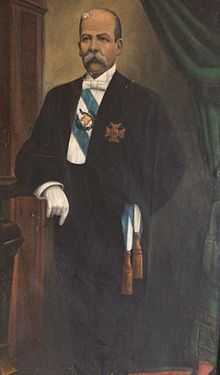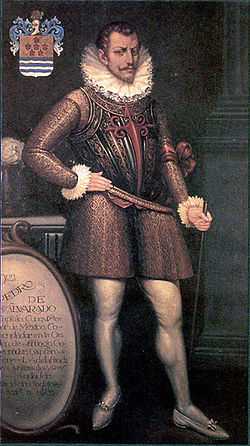Spanish immigration to Guatemala
 | |
| Total population | |
|---|---|
| 8,507,511 (probably 55% of mestizo and direct descendants of Spaniards[1]) | |
| Regions with significant populations | |
| everything except the west | |
| Languages | |
| Guatemalan Spanish | |
| Religion | |
| Roman Catholicism and Protestantism | |
| Related ethnic groups | |
| Guatemalan People, Spanish people, White Guatemalan |
| Part of a series on |
| Spanish people |
|---|
 |
| Regional groups |
Other groups
|
| Diaspora |
|
| Languages |
|
Other languages
|
| Religion |
|
| Spain portal |
The arrival of the Spaniards in Guatemala began in 1524 with the conquest of the territory under the command of Pedro de Alvarado. After the conquest and the colonial era, more people came to the country not as conquerors, but to do business or daily activities.[2] The Spanish embassy in Guatemala City reports some 2,500 Spaniards living in Guatemala in 2006.[3]
History

Early European immigrants from Guatemala were Spaniards who conquered the indigenous Mayan population in 1524. They ruled for almost 300 years. Although the Spanish conquest of Guatemala was primarily the result of its technical superiority, the Spaniards were helped by the Mayans who were already involved in a bitter internal struggle. Following the Spaniards arrival, European epidemics and oppression of conquerors reduced the indigenous population from 14 million to 2 million in two generations. Currently, the population of indigenous people is nearly 5 million.
Despite being greatly outnumbered by the Mayan - historians estimate that only a few thousand Spaniards settled in Guatemala before independence - the latter were able to impose their colonial system through a reign of terror. As a result of Guatemala having few naturally-rich resources, like gold and silver, the Spanish conquest focused their efforts on forced labor of the indigenous population.
The Spaniards established a system of domination that ensured slaves worked the land and paid taxes in the form of goods. The system is structured to exploit the indigenous population without destroying it. In 1663, King Philip IV of Spain tried to abolish slavery in the colonies, but the criollos (those of Spanish origin born in Guatemala), fought fervently to ensure that forced labor continued to practice until the early 20th century.
However, when legislation to safeguard these lands was abolished in the 19th century, the criollos (from Spain, Germany and Switzerland) and Ladino soon came and established plantations producing export crops, turning the rural population into a mass of unemployed migrant farm workers.
In 1821, the Republic of Guatemala - which included the Soconusco region (now part of southern Mexico), as well as what are now the countries of El Salvador, Honduras, Nicaragua and Costa Rica - had just 1.5 million inhabitants, mostly concentrated in the urban centers of the republic. In 1823, after a brief period as part of the Mexican Empire, the republic became known as the United Provinces of Central America.
After a period of political instability exacerbated by the collapse of the world market for indigo, main exporter in the region of Europe, each province seceded from the federation, starting with Costa Rica. The federation collapsed between 1838 and 1840, when Guatemala became an independent nation.[4]
Culture
Spain has contributed much to the culture of Guatemala, the Castilian is the largest Spanish aportacion in Guatemala and is very present in the mestizo and criollo population. The Roman Catholicism is rooted in the Spanish heritage very present in Guatemalan society from the colonial era until today. Several Spanish architectures and constructions found in Antigua Guatemala was part of the colonial period in Guatemala. In 1956 was founded in Guatemala City, the Cultural Center of Spain in Guatemala which is in Zone 4 of the capital, in 2000 this place was remodeled to a more modern atmosphere in this place.[5] And since 1999 the Training Centre of the Spanish Cooperation in Antigua Guatemala has a Library and Documentation Centre specializes in Social Science and Development Cooperation. This is publicly available and is part of BAGE (Libraries of the Central Government), generating resources within the framework of training activities and compliments (2006) with Specialized Carlos Guzman-Böckler and Arturo Taracena Arriola Funds and as the Municipal Archives of Antigua Guatemala.[6]
Language
the Castilian is the largest Spanish aportacion in Guatemala and is very present in the mestizo and criollo population. And about 60% speak that language,[1] is spoken predominantly in the departments of Zacapa, Jalapa, Jutiapa, Santa Rosa, Retalhuleu, Guatemala, Escuintla, Sacatepequez, Izabal, Petén, Chiquimula, El Progreso and San Marcos. For the colonial period, the indigenous were forced to learn the Spanish language, this language is part of the cultural heritage that spain brought in the nation, in addition to Antigua Guatemala is one of the most tourist place for preferred to learning Spanish from all Latin America.
Religion
The Roman Catholicism is rooted in the Spanish heritage very present in Guatemalan society from the colonial era until today. Chiquimula and Sacatepequez are the most Catholic departments in the nation, where several Catholic activities such as Holy Week, Pascua, Christmas Posadas, day of the dead and flying kites, these activities also are performed across the country. In Antigua Guatemala, Sacatepequez there are several cathedrals that are still in function as well as others that were destroyed in the earthquake of 1776, the Holy Week in this department is very celebrated. In Esquipulas, Chiquimula is located one of the largest churches in Central America (the Basilica of Esquipulas), where one worships the black Christ, and ordered built by monks Spaniards in the sixteenth century, its construction is baroque.[7]
Centers and Places
- Embajada de España en Guatemala.
- Centro cultural de España en Guatemala
- Cooperación Española en Antigua Guatemala.
- Restaurante La Altuna.
- Restaurante Tipi Tapa.
- Consejo de residentes españoles en Guatemala.
- Centro cultural en Antigua.
- Hotel Villa Española.
- Hotel Barceló.
- Bar español.
- Cevichería Liga Española.
People and descendants
Just over half of Guatemalans have Spanish blood, though dividing by ethnic groups. It is very difficult to know exactly the exact percentage of mestizos and criollos, therefore according to an estimate taking into account of criollos 10%-12% (direct descendants), 40% Mestizos (Spanish with indigenous) and 5% of castizos (mestizos with Spanish). About over than 8 millions. Over 50% of the population have Spanish surnames.[8]
Notable Spanish Guatemalans
- Mariano Beltranena y Llano.
- Jorge Ubico.
- María Dolores Bedoya.
- Pedro Molina.
- Edwin Escobar.
- Álvaro Arzú.
- Harold Caballeros.
- Cecilia Arimani de Caballeros.
- Irma Flaquer.
- Justo Rufino Barrios.
See also
External links
References
- ↑ 1.0 1.1 "Caracterización estadística República de Guatemala 2012" (PDF) (in Spanish). INE. Archived from the original on November 2012. Retrieved 2014-11-02.
- ↑ Minster, Christopher. "The Maya: Conquest of the K’iche by Pedro de Alvarado". About (Education) (in Spanish). Retrieved 2014-10-29.
- ↑ "Embassy of Spain in Guatemala City, Guatemala". www.embassypages.com (in Spanish). EmbassyPages.com. Retrieved 15 November 2014.
- ↑ Smith, James. "Guatemala: Economic Migrants Replace Political Refugees". MPI. Retrieved 2014-10-29.
- ↑ "The Spain Cultural Center in Guatemala City Has New Facilities". www.guatemaladailyphoto.com. GuatemalaDailyPhoto. Retrieved 15 November 2014.
- ↑ "La Embajada de España en Guatemala informa" (PDF). www.exteriores.gob.es (in Spanish). Embajada de España en Guatemala. Retrieved 15 November 2014.
- ↑ La Basílica del Señor de Esquipulas www.esquipulas.com.gt (in spanish).Retrieved on, 29 October 2014.
- ↑ Guatemalan Academy of Genealogy, Heraldic and Historical Studies
| ||||||||||||||||||||||||||
| ||||||||||||||||||||||||||||||||